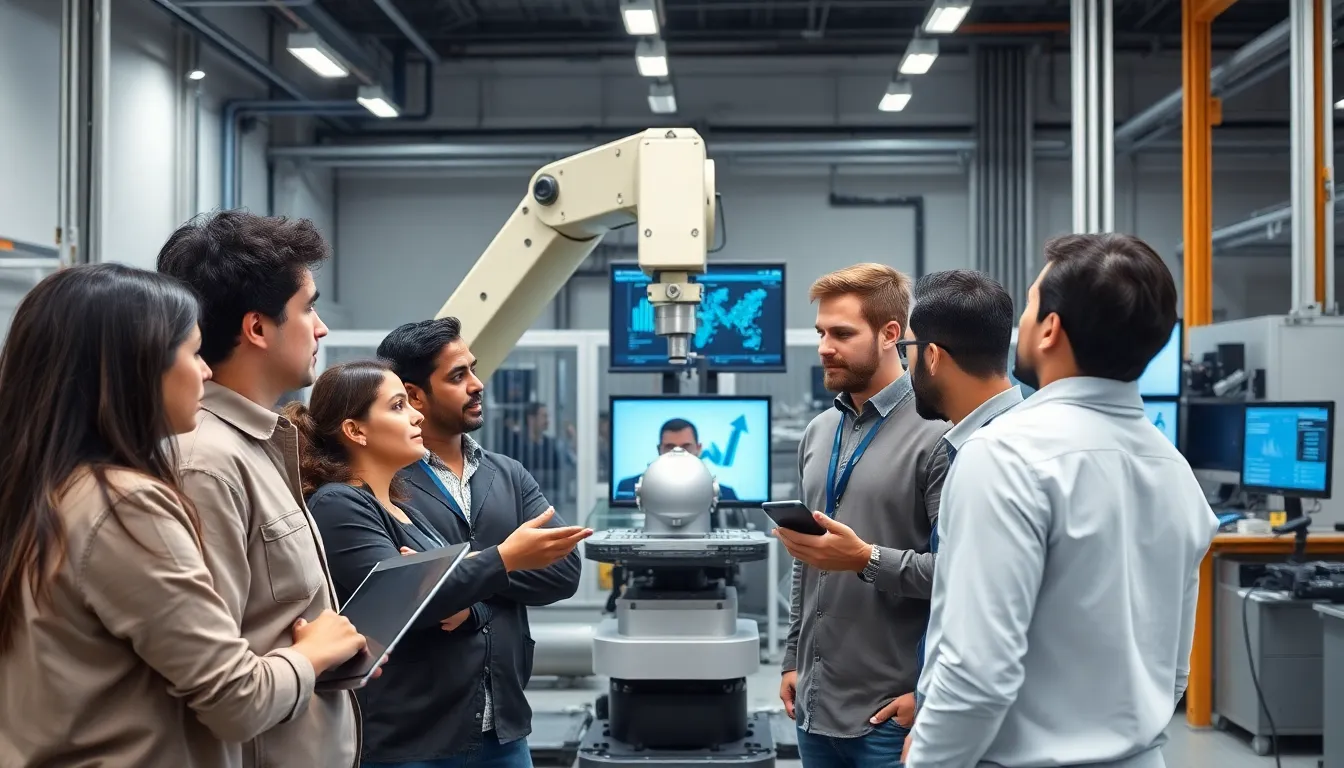Artificial intelligence is no longer just a futuristic dream; it’s the secret sauce transforming engineering as we know it. Imagine a world where machines not only crunch numbers but also predict outcomes with uncanny accuracy. From designing skyscrapers that dance with the wind to optimizing supply chains faster than a caffeinated squirrel, AI is proving to be the ultimate engineering sidekick.
But what’s the real impact factor of AI in engineering? It’s more than just a buzzword; it’s a game-changer. As engineers harness AI’s powers, they’re not just improving efficiency—they’re redefining the very fabric of innovation. Buckle up as we dive into the fascinating realm of AI applications in engineering, where creativity meets technology and the possibilities are as endless as a toddler’s energy on Halloween night.
Table of Contents
ToggleOverview of Artificial Intelligence in Engineering
Artificial intelligence (AI) plays a crucial role in modern engineering applications. Engineers leverage AI to improve decision-making processes and enhance performance across various sectors. Automation of routine tasks allows for increased focus on creative problem-solving, driving innovation forward. Predictive analytics, a key component of AI, assists engineers in forecasting project outcomes, minimizing risks, and optimizing resource allocation.
In structural engineering, AI algorithms analyze building designs, ensuring safety and efficiency. Enhanced simulations aid in identifying potential weaknesses in architectural plans before construction begins. Manufacturing processes benefit from machine learning, which optimizes production lines and reduces waste. Data-driven insights help streamline operations and increase productivity in industries such as aerospace and automotive.
AI’s ability to process large data sets significantly influences supply chain management as well. Intelligent systems predict demand fluctuations, optimizing inventory levels and minimizing costs. Real-time monitoring of equipment helps in predictive maintenance, thus prolonging the lifespan of machinery and reducing downtime.
Environmental engineering also utilizes AI for improving sustainability. AI models assess environmental impacts and guide eco-friendly design choices. Heuristic algorithms facilitate better energy management within buildings, contributing to overall energy efficiency.
Project management sees advancements through AI-enabled tools that enhance collaboration and communication among teams. By analyzing workflows and timelines, AI identifies bottlenecks and recommends solutions, improving project outcomes. The convergence of AI and engineering fosters an innovative landscape, pushing the boundaries of what’s possible in design and execution.
Key Engineering Applications

Artificial intelligence significantly enhances engineering practices across various sectors. Key applications include robotics and automation, predictive maintenance, and design and simulation.
Robotics and Automation
Robotics and automation play a pivotal role in modern engineering applications. AI algorithms enable machines to learn from environments, improving their operational efficiency. For instance, automated assembly lines in automotive manufacturing utilize AI for precision and speed. Additionally, robotic systems equipped with AI can adapt to changes, enhancing flexibility in production processes. This adaptability leads to reduced labor costs while increasing safety by handling hazardous tasks. In construction, drones equipped with AI monitor job sites, providing real-time data for project management and progress tracking.
Predictive Maintenance
Predictive maintenance revolutionizes how engineering teams manage equipment reliability. By analyzing data collected from machinery, AI predicts potential failures before they occur. This proactive approach minimizes unexpected downtimes and reduces repair costs. For instance, in manufacturing plants, sensors monitor equipment performance, feeding data to AI systems. These systems identify patterns, allowing engineers to schedule maintenance during non-peak hours. Ultimately, predictive maintenance extends equipment lifespan and optimizes maintenance schedules, resulting in enhanced operational efficiency.
Design and Simulation
Design and simulation benefit immensely from AI technologies. Engineers can deploy AI-driven simulation tools to test design variations rapidly and accurately. Machine learning models analyze vast datasets, providing insights that inform design decisions. In architectural engineering, AI assists in optimizing structural designs for safety and aesthetics. Simulations predict how structures respond to environmental factors, helping to ensure compliance with safety regulations. Overall, AI enables engineers to create innovative designs more efficiently, saving time and resources in the development process.
Understanding Impact Factor
Impact factor serves as a key performance metric for evaluating the influence of scholarly articles in engineering fields, particularly those involving artificial intelligence. This metric reflects the frequency with which an average article in a particular journal has been cited in a specific timeframe, thus indicating its relevance and contribution to ongoing research and innovation.
Definition and Importance
The impact factor quantifies the influence of journals and their articles within the engineering community. Researchers rely on it to identify reputable sources, guiding their literature reviews and supporting their findings. High impact factors are pivotal, as they signal well-cited research, drawing attention to significant advancements and fostering engagement among scholars and practitioners alike. Publications with elevated impact factors often drive trends in technology, pushing engineering boundaries and inspiring further innovations.
Measuring Impact in Engineering
Measuring impact within engineering involves various methodologies beyond just the impact factor. The h-index offers insight into a researcher’s cumulative impact, communicating both the quantity and quality of their publications. Citation analysis serves another vital function, revealing how frequently works are referenced within the field, thereby demonstrating their significance. Furthermore, altmetrics analyzes social media mentions, downloads, and shares to capture broader engagement with engineering research. Collectively, these metrics illustrate the multidimensional impact of artificial intelligence in engineering, offering a comprehensive view of its transformative influence.
Case Studies of AI Impact in Engineering
Exploring real-world examples showcases the significant impact of artificial intelligence across engineering disciplines. Various sectors have implemented AI successfully, producing remarkable results.
Successful Implementations
Case studies highlight the utility of AI in structural engineering. A leading firm used AI algorithms to evaluate safety in building designs, resulting in 30% faster approval times. In automotive manufacturing, an AI-driven automated assembly line increased production efficiency by 20%, showcasing the technology’s transformative influence. Similarly, a predictive maintenance system in a major aerospace company reduced downtime by 25%, optimally scheduling repairs based on real-time data. These successful deployments illustrate AI’s ability to enhance operational performance and drive innovation.
Lessons Learned
Implementations of AI in engineering reveal key takeaways. Organizations learned that initial investments in AI infrastructure often pay dividends through long-term efficiency gains. Resistance from employees may occur, highlighting the need for robust training programs to ease transitions. The integration of AI also emphasizes the importance of collaboration between engineers and data scientists. Developing a culture that embraces data-driven decision-making fosters acceptance and maximizes AI benefits. Ultimately, these lessons shape future strategies, ensuring that AI continues to propel engineering innovations forward.
Future Trends in AI and Engineering
Advancements in AI continue to shape engineering disciplines, creating new trends that promise to redefine industry standards. Emerging technologies within AI, such as deep learning and natural language processing, increasingly facilitate complex engineering tasks. Engineers now utilize these tools to enhance design processes, optimize workflows, and drive innovation at unprecedented speeds.
Robotics technology undergoes rapid evolution as AI integration improves automation capabilities. Automation systems gain sophistication through AI algorithms, enabling them to adapt to changing project parameters dynamically. Construction sites, for example, feature autonomous equipment guided by AI, which minimizes human error and enhances operational safety.
Data analytics experiences a transformation thanks to AI’s predictive capabilities. Engineers leverage this data to improve decision-making processes critically, resulting in enhanced project outcomes and reduced inefficiencies. Analyzing large datasets enables teams to anticipate challenges and respond proactively, significantly reducing delays.
Sustainable practices gain importance in engineering, with AI models assessing energy consumption and waste generation. Implementing these models supports engineers in making eco-friendly design choices, which aligns with increasing regulatory demands for sustainability. Projects benefit from AI’s ability to predict and evaluate environmental impacts during the planning phase, leading to smarter solutions.
Collaboration and communication enhance significantly through AI-driven project management tools. These tools streamline teamwork by identifying bottlenecks and proposing actionable solutions in real-time. Clarity in communication fosters an environment where engineers and data scientists can work together harmoniously, propelling innovation further.
Future engineering applications of AI entail significant enhancements in safety, efficiency, and sustainability. As industries adopt and refine these technologies, the landscape evolves rapidly. The intersection of AI and engineering holds promise for transformative advancements that will shape the future of the field.
The integration of artificial intelligence in engineering is reshaping the landscape of innovation and efficiency. By automating processes and enhancing decision-making, AI empowers engineers to focus on creative solutions and strategic advancements. Its impact spans various disciplines, from optimizing supply chains to improving safety in structural designs.
As AI continues to evolve, its role in engineering will only grow more significant. The ability to predict outcomes and streamline operations positions AI as a critical tool for future advancements. Embracing this technology not only fosters innovation but also ensures that engineering practices align with sustainability goals, paving the way for a more efficient and responsible future.






